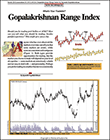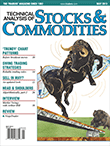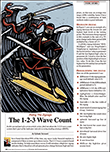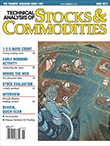 Editor,
Editor,I recently came across the Gopalakrishnan range index (“Gopalakrishnan Range Index,” Stocks & Commodities, January 2001). Do you have this indicator for Microsoft Excel? I would be very happy if I could implement it in an Excel spreadsheet.
LETTERS TO THE EDITOR
The editors of S&C invite readers to submit their opinions and information on subjects relating to technical analysis and this magazine. This column is our means of communication with our readers. Is there something you would like to know more (or less) about? Tell us about it. Without a source of new ideas and subjects coming from our readers, this magazine would not exist.
Address your correspondence to: Editor,
Stocks & Commodities,
4757 California Ave. SW, Seattle, WA 98116-4499, or E-mail to editor@traders.com.
All letters become the property of Technical Analysis, Inc. Letter-writers
must include their full name and address for verification. Letters may
be edited for length or clarity. The opinions expressed in this column do not
necessarily represent those of the magazine. —Editor
 Editor,
Editor,
I recently came across the Gopalakrishnan range index (“Gopalakrishnan Range Index,” Stocks & Commodities, January 2001). Do you have this indicator for Microsoft Excel? I would be very happy if I could implement it in an Excel spreadsheet.
Antonio
The article included a sidebar on how to implement the indicator in Excel (“Calculating GAPO With Excel”). Readers can access the article and sidebar in the article archive at our website, www.traders.com.—Editor
 Editor,
Editor,
Congratulations to Sylvain Vervoort on his well-written articles (“Indicator Rules For Swing Trading Strategies,” parts 1 & 2, May and June 2013) that do a good job of explaining the rules for swing trading. I’ve been working on an objective system for futures trading myself. The rules have been working very well. I would like to expand this to swing trading equities, so I am intrigued about what Vervoort has to offer. Will he be offering the indicators for the TOS (thinkorswim) platform? I look forward to learning more about his system.
Mark
Author Sylvain Vervoort replies:
Code for several charting platforms based on my swing trading strategy has been published in the Traders’ Tips section of the June 2013 issue of S&C, available at the S&C website at www.traders.com in the Traders’ Tips area. If TOS is not represented there, you might try contacting thinkorswim regarding possibly getting code to use for the strategy.
 Editor,
Editor,
I read Sylvain Vervoort’s article in the June 2013 S&C (“The 1-2-3 Wave Count,” which is the second part of a series on indicator rules for a swing trading strategy) and wish to get the code for use in NinjaTrader to implement the technique, but I cannot locate the .zip file. Do I take the code and create a .zip file from that to import into NinjaTrader? Or is the SVEHLZZperc.zip file already created?
Curtis
Author Sylvain Vervoort replies:
The zip file is already created and ready to import into NinjaTrader. You can download this file from my website from https://stocata.org/ninjatrader/zipfiles/SVEHLZZperc.zip, or to navigate to this link at my website, go to https://stocata.org, then click on the technical analysis menu, then click on NinjaTrader formulas, then click on the item named “1-2-3 wave count.” Download the basic NinjaScript formula, SVEHLZZperc.zip.
This zip file can also be downloaded from the S&C website from https://traders.com/files/Vervoort-NinjaTrader.html or from the S&C Article Code area at the S&C website, www.traders.com (scroll down to the June 2013 issue).
Editor,
Thank you for Sylvain Vervoort’s recent articles in S&C. I am looking forward to reading and implementing all of them.
I just downloaded the SVEHLZZper file. The figures in Vervoort’s articles show numbers at turning points, but my chart doesn’t show any numbers on the zigzag. I am missing something, or this is how it is?
Javier
Author Sylvain Vervoort replies:
The high-low zigzag does not automatically show the 1-2-3 wave count. This is done manually. Once you are used to how to count the 1-2-3 waves, there will be no need to keep a manual count, because mostly, you will just be looking at the last couple of waves.
In my July 2013 article in which I use the zigzag to identify candlestick patterns at the turning points (“The Step Candle Pattern,” which is the third part of my series on indicator rules for a swing trading strategy), an identification of the found pattern will be written automatically.
 Editor,
Editor,
I read Sylvain Vervoort’s article “1-2-3 Wave Count” published in the June 2013 S&C. His suggestion is to enter long on an expected wave 3 or 1. But I cannot find the way to forecast targets for wave 3, even if I am guessing the author uses a Fibonacci projection of 168.2% applied to waves 1-2 and a trigger signal is given by the breakout of wave 1 top.
Nicolas
Author Sylvain Vervoort replies:
Please keep in mind that the 1-2-3 wave count is just one of the rules to look at for the IRSTS (indicator rules for a swing trading strategy). You look for a wave 1 or 3 because a wave 2 is a correction wave, and as such, is mostly limited to a 50% retracement of the previous wave 1 or 3. The wave count does not predict a target price, except that a wave 1 or 3 will move beyond the top or bottom of the previous wave 1 or 3.
To estimate the target price, other techniques can be used, such as different Fibonacci projections, price channels, pitchforks, support/resistance, and so on.
Editor,
I was wondering if author Sylvain Vervoort has coded the typical price and heikin-ashi TEMA average crossing for use on the NinjaTrader platform.
Tristan
Author Sylvain Vervoort replies:
I am in the middle of presenting a series of articles in S&C on IRSTS (indicator rules for swing trading strategies) trading system setup. (Part 4 appears in this issue, titled “Within The Volatility Band.”) The series began with the May 2013 issue. Part of the overall strategy involves the heikin-ashi with the typical cross, and an article in the series addressing this topic will appear in an upcoming issue of S&C. The article will include the source code.
Editor,
I have been a subscriber to S&C for many years. I am 75 years old. I worked on Wall Street for 35 years as an analyst and equity portfolio manager and since retiring have followed the market closely.
I am writing to suggest an additional feature for your magazine because I think the content has deteriorated over the last few years. Many of your articles have gotten away from any discussion of the basics of technical analysis, and too many are now emphasizing highly mathematical models and approaches that can be of interest to only a few of your readers. An example of this is the second article of a seven-part series titled “The 1-2-3 Wave Count” by Sylvain Vervoort in the June 2013 S&C. How many of your readers are going to go through all those formulas, rules, and exceptions and use them? I don’t think very many. When I see an article like that, it’s an automatic pass.
In the 1960s and ’70s when I worked in New York City, there was a publication titled The Financial Analysts Journal started by some people connected with The New York Society of Security Analysts. The initial articles were great because they covered some of the basics of investing and different approaches used and were written in a clear, readable style. Then, after a few years, the academics took over the magazine, and the articles dealt only with obscure mathematical models that were hard to understand and only of interest to a very few readers. This is the same type of trend that your magazine has shown recently. Instead of broadening interest in your magazine, I think you are narrowing it with your approach.
Recently, I have been going through some of your back issues that were published 13 years ago. Those issues had great articles on basics written by Martin Pring, such as “Peaks And Troughs” in May 2000; “Picking Out Your Trading Trend” in April 2000; “Using The Simple Moving Average” in June 2000; “Volume Basics” in July 2000; “Catching DJIA Breakouts” by Mark Vakkur in August 2000; “Trading Stochastic Pops” by David Steckler in August 2000; and “Trend-Following With The ADX” by Martin Boot in September 2000. These are a few of the articles that I have cut out and saved.
Why don’t you start a new section in your magazine, perhaps titled “A Review Of The Past,” and reprint a couple of those articles on basic technical analysis in each issue? Go all the way back to your early issues and reprint some of those articles covering the basics. Cut back on the articles with detailed models. The basic articles would be highly attractive to new students of technical analysis and could broaden the market for your magazine. How many of those new technical students are going to wade through pages of formulas and rules? I don’t think many. Even for long-term students of technical analysis, a review of the basics could be quite welcome — it certainly would be for me.
Ronald Stuart
Thank you for taking the time to write and share your suggestions, and thank you for being a longtime subscriber to S&C. We appreciate your feedback as well as your patronage.
At different points, we have made slight changes to our format so our content reflects changes in the markets or in technology, as well as to adjust to what readers are looking to gain from reading S&C. Since much basic information can be found these days over the Internet, we try to publish some of the more sophisticated implementations of techniques and other material that cannot be readily found on the Internet or elsewhere. In addition, part of our editorial mission has always been to provide either code, formulas, spreadsheets, or other computerized support to make implementing sophisticated techniques easier. (In fact, the very first issue of this magazine in 1982 contained computer code, and we were the first magazine on trading to do so!)
We do try to include a balance of articles in each issue, ranging from the more basic, shorter, easy-to-read articles to the longer, more involved articles that may model techniques or develop a system from the ground up. For example, in the same issue as “The 1-2-3 Wave Count,” we also featured an article on how economic news can affect traders; a daily stock evaluation method that anyone with access to a computer and printer can use; and an interview with a trading mentor who tells us that it’s possible to become a successful trader by using simple techniques.
Admittedly, it can be difficult to suit all readers’ tastes all the time, since different types of traders seek different approaches; thus, we try to provide a variety of topics. We have many readers who value the more sophisticated articles and subscribe because of them. We try to monitor readers’ feedback by way of reader surveys on articles and by way of Internet traffic. Readers may also drop us a line at editor@traders.com to express their interests or disinterests.
As for your suggestion of revisiting past articles, subscribers to S&C can now access all past issues of S&C from our website, www.traders.com, in our Article Archive area — going back to the first issue. Thus, subscribers have the opportunity to revisit all the articles you mention and more, all for the cost of a subscription to the print magazine! We hope that subscribers will take your suggestion of reviewing some of our past content and explore all that our archive has to offer.—Editor